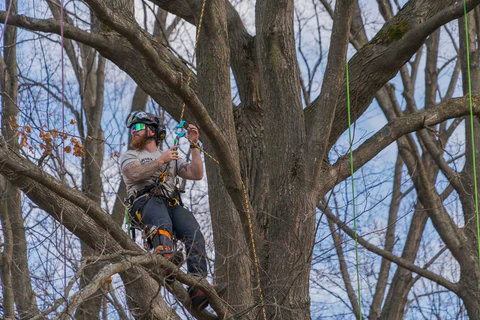Utility Line Clearance Tree Trimming
Utility Line Clearance Tree Trimming
Step into the world where nature and infrastructure collide, where arborists become artists, and the symphony of chainsaws harmonizes with the rustle of leaves. Utility line clearance tree trimming is not merely a job; it’s a delicate dance between human ingenuity and the untamed beauty of trees!
Maintaining a safe and reliable power supply is a crucial aspect of modern living, and one often overlooked element of this is utility line clearance tree trimming. Trees, while providing numerous benefits, can pose a significant threat to power lines, if not properly managed. Utility line clearance tree trimming is referred to as “The Dark Side” of Arboriculture and the trimmers are often referred to as “hacks”. This statement is far from the truth! There is a plethora of arborists that work in the Utility sector and try their hardest to prune according to ANSI A300 standards.
Electricity: we all rely on it to power up our homes, yet homeowners and “others” may overlook the dangers that are associated with working around these electrical conductors. I too was quick to judge, but this was before I understood the power lines and why the trimming is performed as it is. There is a method to the madness that I am now aware of. I will state that the saying, “Clearance not Appearance”, does not help the Utility line clearance trimmer’s case but it actually is true.
Utility Line Clearance Tree Trimming line clearance tree trimmers are not hired by the homeowners, they are working for the Utility Provider. This is one big reason why they don’t like the Utility trimmers; that and the fact that the tree might look like it received a scalping when we are done with it. To prove that homeowners aren’t too fond of line clearance trimmers, let me paint this picture; late night is upon us while we work in a homeowner’s backyard, she was made aware that we would be there well into the night, clearing out a large tree that had caused an outage. I drew the short straw and worked the ground with our apprentice. Lights were set up as we continued to work into the night and the homeowner released two Doberman Pinschers! Immediately, I went into a Usain Bolt sprint!
Remember, the main goal for line clearance: clear the surrounding area near the power lines to prevent outages and reduce interference to the homeowner’s power supply as they enjoy watching Sunday night football. As stated before, plenty of us practice appropriate pruning standards, where applicable. On the other hand, utility trimmers along with Lineman (often work hand-in-hand), are praised as hero’s when it comes to large storm outages. I have worked with them during these large storms; working long hours, ensuring that it will be safe for the Lineman to raise power lines and to restore power. This process can be long and grueling, but they haul ass!
As with all tree trimming, assessment and planning is still required:
Survey the area around the power lines and identify the trees that pose risk.
Evaluate the distance between trees and power lines. There might be times where climbing the tree or working on it is not feasible and a shutdown must occur. The employer and the utility might not like it, but it is much preferred to a burial. This won’t be something as simple as removing a tree by a home; those things can be replaced, you however, cannot!
Learn to identify what hardware (e.g. fuse, ground leg, hot leg, jumper, lightning arrestor …) is being used on the utility pole. This will help identify what voltage you are working and to establish M.A.D. (minimum approach distance). It will also help you quickly determine when pole top hardware is faulty, broken, or missing. Please keep in mind, voltage running through the system may vary from region-to-region. Just because you can correctly identify the equipment does not mean the voltage is the same.
Finally, develop your attack plan.
Safety Measures:
Wear your PPE accordingly. I bring this up for an important reason, (other than it is necessary per OSHA, ANSI and more than likely your employer) avoid wearing polyester clothing around these electrical systems. If a flash occurs, it will get hot and that shiny polyester shirt will melt to your skin!
Something easily overlooked and that we ALL may have done, having used tools within M.A.D. I hate to break it to you (if you don’t already know) but apart from our body, our gear (including but not limited to, climbing lines, rigging lines, throw lines), tools, and equipment shall maintain M.A.D. as well.
Proper Equipment:
Something I can’t stress enough, use the correct equipment! For those of us in the utility sector, we must use insulated tools that meet the requirements and ensure they are still in good operating condition. Our pole pruners must undergo testing, there may be pole pruners that receive individual testing and those that are batch tested. The company you work for will have it written as to which they will need. So, if you intend on having a personal pruner, ask first.
Helmets, different makes, fits, styles. Yes, they all are designed to protect your head (some offer more), but in the line clearance industry, you must have a Class E helmet. Class E helmets undergo testing to withstand 20,000 volts of electrical current and to protect the user’s head from arc flashes and electrical shock.
If you can get an aerial unit to the work area, use it! Importantly, because the aerial lifts used in Utility have insulated portions, This does not make the user nor the equipment invincible.
What are your thoughts on Utility Line Clearance Tree Trimming?



Leave a Reply
Want to join the discussion?Feel free to contribute!